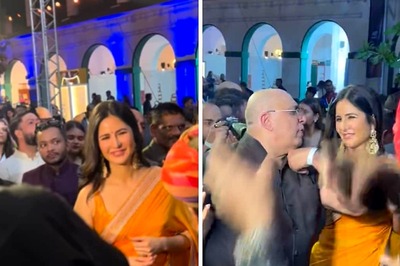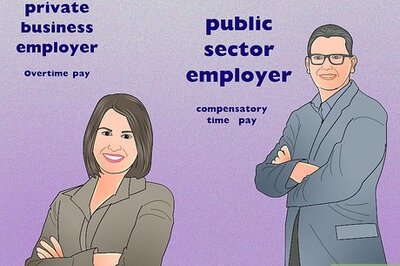
views
The post 1978 history of the Congress confirms Prime Minister Narendra Modi’s allegation that the high post of Congress president has been almost reserved for a member of the Nehru-Gandhi family. Except for the six-year term of PV Narasimha Rao and barely year-and-a-half tenure of Sitaram Kesri, Indira Gandhi, Sonia Gandhi and Rahul Gandhi have occupied the top party job for 32 of the last 40 years.
The Congress may view the issue of dynastic succession as an internal matter and near-consensus as a sign of democratic exercise, but the move to elevate Rahul Gandhi as AICC president in the midst of 2017 Gujarat assembly polls was bad optics. The sight of the entire Congress party bowing before Rahul, who was elected unopposed, helped Modi-led BJP focus on the theme of dynasty politics. It is also a fact that dynasty politics has become part and parcel of most political parties in India and inner party democracy is non-existent among all regional and national political parties. But the charge of perpetuating dynasty politics sticks to the grand old party.
Addressing a public rally in Chhattisgarh's Ambikapur on November 16, Modi had remarked, "I want to challenge them (Congress); get a good leader from outside the (Nehru-Gandhi) family to become the party president for five years, then I will say that Nehru ji really created a truly democratic system there."
However, a closer look at the 133 years of the Indian National Congress shows that Nehru-Gandhi family members have been at the helm of the party for 46 years. Sonia Gandhi holds the record of being the longest-serving party chief — 19 consecutive years from 1998 to 2017.
From Motilal Nehru-era till Rajiv Gandhi, the party had Nehru-Gandhi family members for merely 27 years. Jawaharlal Nehru served as AICC chief for 11 years, Indira seven, Rajiv six and Motilal Nehru for two years. While Motilal Nehru was AICC president in 1919 and 1928, his successor Jawaharlal Nehru took over in 1929. Nehru was Congress president in 1930, too, and between 1935 and 1938. After Prushottam Das Tandon’s resignation, Nehru took over in 1951 and remained AICC chief till 1955. Indira Gandhi served for a year in 1959 and from 1978 onwards she remained the party chief till her death in October 1984. Rajiv Gandhi remained party president from 1984 till his death in May 1991.
Here is a brief look at members of the Nehru–Gandhi family when they took over as the AICC president.
Motilal Nehru
It was during the 34th session of AICC held on December 26, 1919 that Motilal Nehru was elected as AICC president in the presence of Mahatma Gandhi and many other stalwarts.
Motilal was 60 then, extremely westernised and was not considered a man to be easily swept off his feet. Initially, he was against any extra-constitutional measures against the British Raj, but the Jallianwala Bagh massacre in April 1919 that left 379 defenceless people dead changed him completely. The Jallianwala Bagh holocaust was followed by martial law. Motilal Nehru did what he could to bring succour to those who had been condemned to the gallows or sentenced to long terms of imprisonment.
Jawaharlal Nehru
Mahatma Gandhi proposed Jawaharlal Nehru’s name for presidency of the Congress in Lahore on the bank of river Ravi. Jawaharlal, barely 40, was somewhat embarrassed, but Motilal was overjoyed and quoted a Persian adage: “Harche ki pidar natawanad, pesar tamam kunaad (What the father is unable to accomplish, the son achieves).”
Jawaharlal received such a grand welcome that a newspaper said “even the kings might envy.”
Indira Gandhi, aged 12, was present to witness the historic moment with Motilal and Swarup Rani who watched the proceedings from the balcony of Bhalla Shoe Company at Anarkali Bazar Lahore, showering petals. Lahore, the Punjab capital then, wore a festive look that day.
Pran Chopra, a Congress supporter who later became a distinguished journalist, was present that day and recorded, “When Nehru came to Lahore, he was in the eyes of many a very romantic figure. He was handsome, he was dedicated. He inspired a kind of response which I do not think anyone other than Gandhi had inspired among the people.”
Indira Gandhi
When Indira Gandhi became Congress president for a year in 1959 much to the surprise of many at a time when her father was prime minister, many had viewed the development as the then PM’s bid to push his daughter into the coveted post. But a large section of Congressmen of that era had felt that Indira was brought in to perform a ‘hit job’, something Jawaharlal was uncomfortable doing.
The Nehru cabinet had dismissed EMS Namboodiripad's first democratically elected Left government in Kerala, despite its majority in the Legislative Assembly on then governor Burgula Ramakrishna Rao's recommendation.
The Namboodiripad regime had initiated sweeping land reforms and introduced an educational bill regulating and controlling plethora of privately run schools, upsetting influential Christian Church, the Muslim League and Nair Service Society which soon developed into mass movement for removal of Namboodiripad government.
When Indira’s term ended in 1960, the Congress Working Committee tried hard, requesting her to stand for re-run, but she declined firmly. Indira returned to active politics after Jawaharlal’s death in 1964.
Rajiv Gandhi
Indira Gandhi’s assassination, the breakout of anti-Sikh riots and Rajiv Gandhi’s swearing-in as prime minister on October 31, 1984 were so dramatic that a fourth generation Nehru-Gandhi family member taking over as head of the Congress was lost in the din. There was no AICC or CWC to elevate Rajiv. At a meeting of party general secretaries held in the evening of October 31 at 24, Akbar Road that passed a condolence resolution recalling Indira’s services, veteran Kamlapati Tripathi proposed Rajiv’s name. The event even failed to figure in the next day’s newspapers, but found a mention in the annual general secretary’s report, which was presented at the Congress Centenary Session at Brabourne Stadium, Bombay on December 28, 1985.
Sonia Gandhi
On March 14, 1998, 24 Akbar Road was a mute witness to a coup that saw the rather unsavoury exit of an ‘elected’ Congress president and the appointment of Sonia Gandhi as party chief.
Sitaram Kesri, then 79, had arrived at the CWC meeting convinced that a party president could not be forced out. He did not know that before the 11 am meeting, most CWC members had gathered at Pranab Mukherjee’s home to endorse two crucial statements. The first was an ultimatum asking Kesri to step down; the second, a resolution replacing him with Sonia Gandhi.
The moment Kesri stepped into the hall, he knew something was amiss. Loyalist Tariq Anwar was the only one who stood up to greet him. After Kesri sat down, Mukherjee began reading out a resolution 'thanking’ him for his services.
A horrified Kesri shouted “Arre yeh kya keh rahe ho (what are you saying)”, but there was a smirk on the faces of his colleagues. Kesri raved against the ‘unconstitutional’ meeting and stormed out, followed by loyalist Anwar. As he was getting into the car, he was heckled and some Youth Congress workers even tried to pull down his dhoti.
By the time Kesri exited 24 Akbar Road, the nameplate outside what used to be his room was already replaced with a computer printout that read said: ‘Congress President Sonia Gandhi’.
(The author is visiting fellow at the Observer Research Foundation and journalist. Views are personal)




















Comments
0 comment